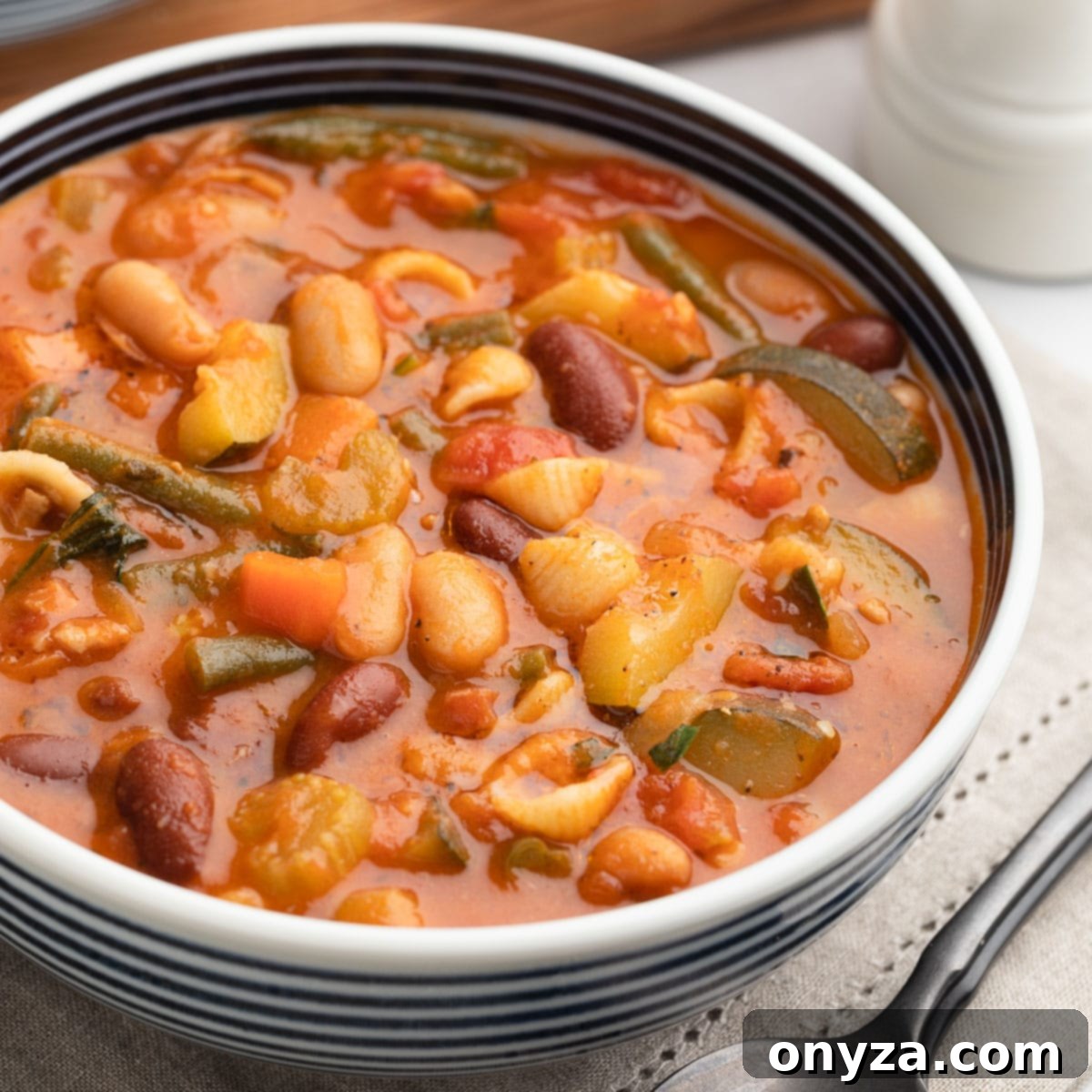Minestrone Soup is more than just a meal; it’s a celebration of seasonal bounty, a comforting hug in a bowl, and a testament to Italian culinary wisdom. This classic Italian favorite is a hearty, wholesome, and endlessly adaptable dish, brimming with vibrant vegetables, nourishing beans, and tender pasta, all swimming in a rich, flavorful tomato-based broth. It’s the perfect recipe for making the most of whatever fresh produce you have on hand, transforming simple ingredients into a deeply satisfying experience.
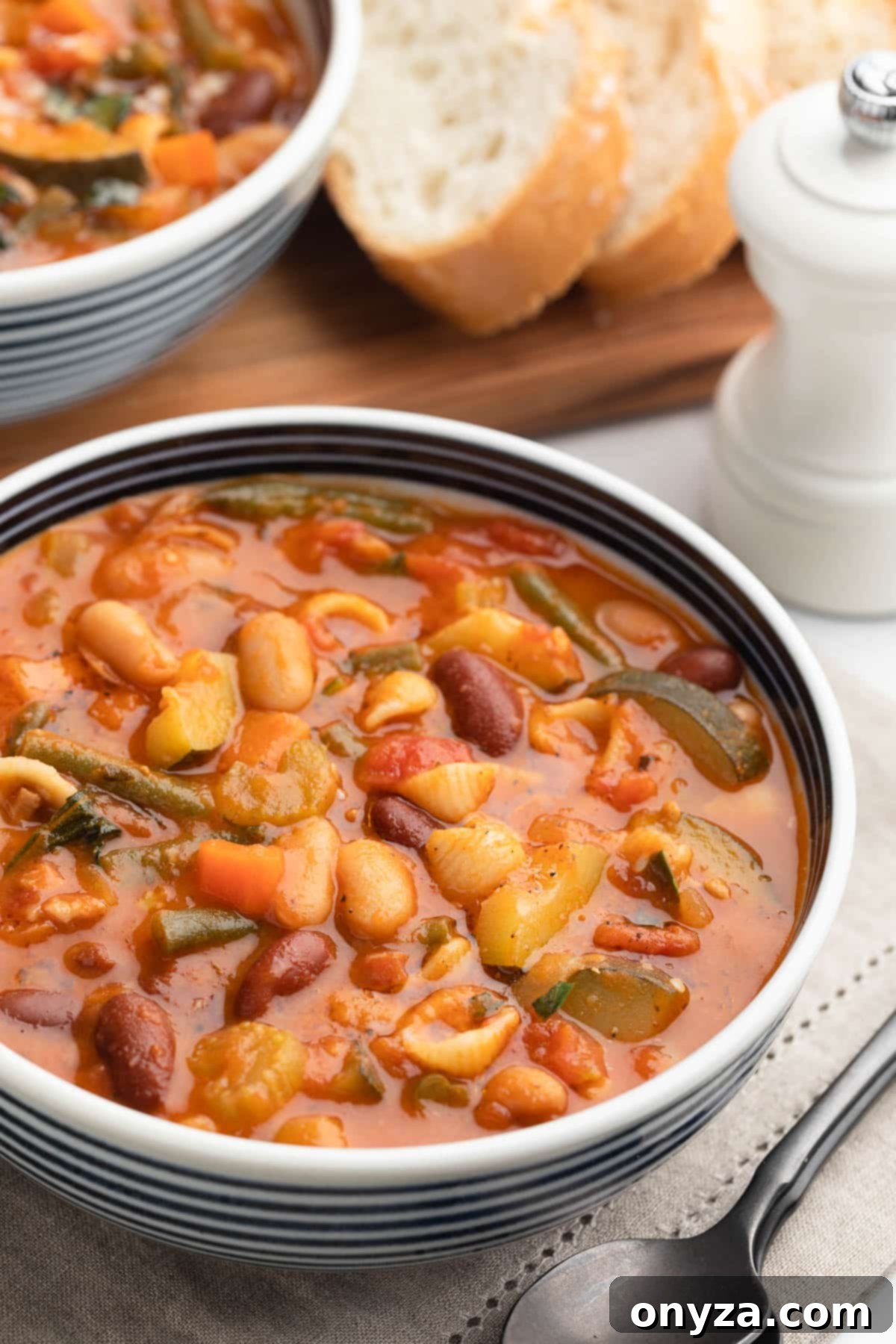
Discover the Essence of Minestrone Soup
Originating as a “cucina povera” (peasant food) dish in ancient Rome, Minestrone Soup was born out of necessity and ingenuity—a way to utilize whatever vegetables were available. This rich history means there’s no single, definitive Minestrone recipe. Instead, it evolves with each region, season, and cook. Some versions are light and brothy, while others, like the robust recipe we’re exploring today, are wonderfully thick and hearty, promising a truly filling meal.
- **Broth is Key:** While this recipe suggests 6 cups of chicken or vegetable broth, I highly recommend having a full 2 quarts (8 cups) on hand. This allows you to effortlessly adjust the soup’s consistency to your personal preference, ensuring it’s never too thin or too thick.
- **The Pancetta Difference (and Vegetarian Option):** My recipe includes pancetta, the Italian salt-cured pork belly, which adds an incredible layer of rich, savory depth to the broth. However, Minestrone is incredibly versatile. To make this recipe completely vegetarian, simply omit the pancetta and use a quality olive oil as your initial cooking fat instead. The soup will still be wonderfully flavorful!
Crafting the Perfect Minestrone: A Step-by-Step Guide
Creating a truly exceptional Minestrone is a rewarding culinary journey. We’ll break it down into manageable steps, ensuring a delicious outcome every time.
Step 1: Mise en Place – The Foundation of Flavor
The most time-consuming aspect of this soup is the initial ingredient preparation, or “mise en place.” I like to dedicate about 30 minutes to this crucial step—measuring, chopping, and getting everything ready before I even turn on the stove. Don’t let this initial commitment deter you; once your prep is complete, the rest of the soup comes together with remarkable ease. Here’s a detailed look at the fresh ingredients you’ll need to have ready:
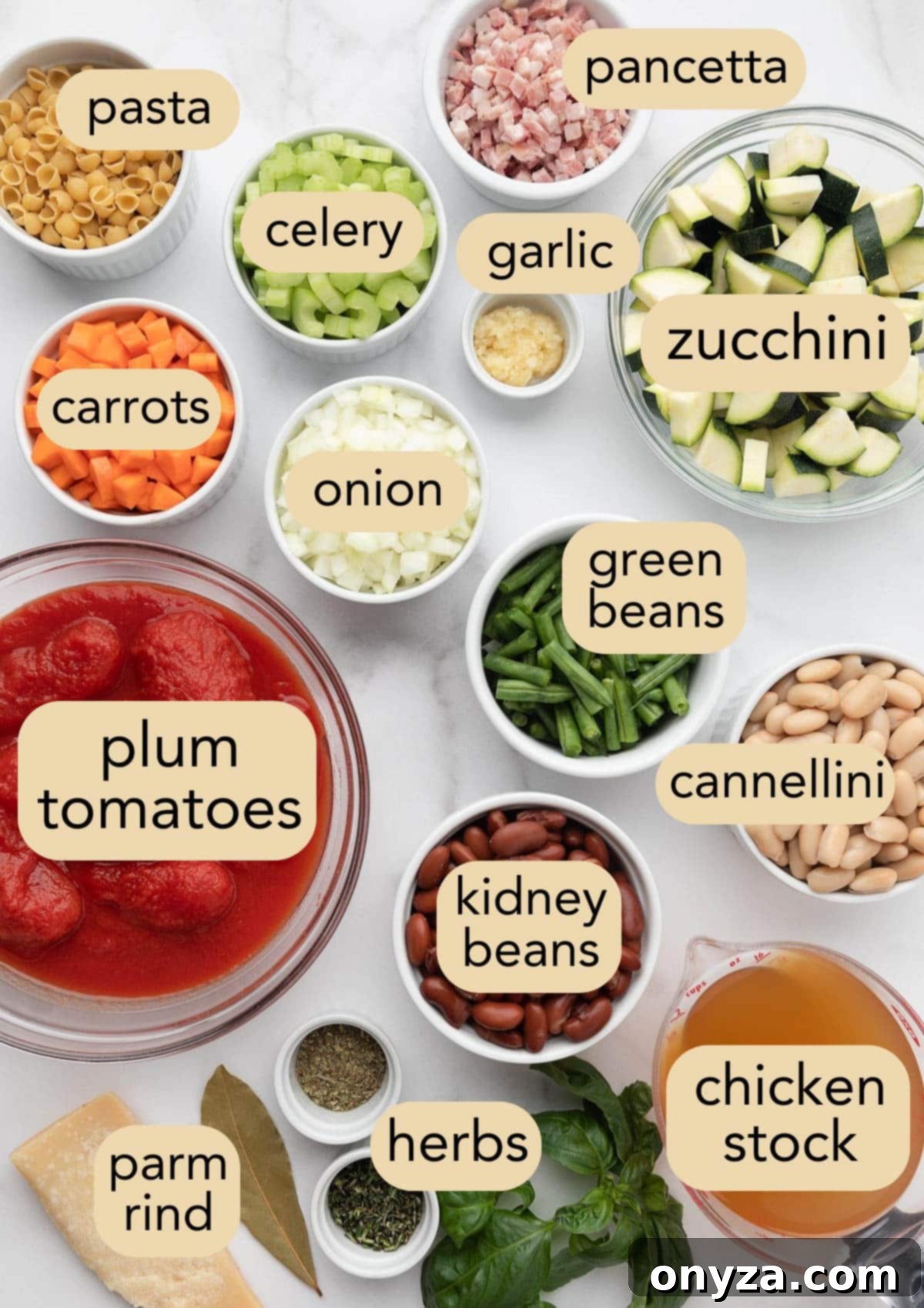
- Pancetta: For ultimate convenience, pre-diced pancetta is a fantastic choice. If you’re working with a slab, aim for small, consistent 1/8- to 1/4-inch pieces. This ensures the fat renders beautifully into the soup, infusing it with flavor without leaving large, chewy chunks.
- Celery, Carrots, and Onion (The Mirepoix): These three vegetables form the aromatic base of many great soups. Peel and dice your carrots and yellow onion into uniform 1/4-inch pieces. Slice the celery into equally sized 1/4-inch thick pieces. Consistency in size promotes even cooking.
- Garlic: Freshly minced garlic is non-negotiable for vibrant flavor. A garlic press is your best friend here, creating a fine texture that practically melts into the soup, distributing its pungent goodness throughout.
- Zucchini: There’s no need to peel your zucchini; the skin adds color and nutrients. Slice it into 1/4-inch rounds, then quarter each round. If you encounter a particularly large zucchini (over 1-1/2 inches in diameter), it’s best to dice it into uniform pieces instead to ensure it cooks evenly with the other vegetables.
- Green Beans: Whether fresh or frozen, green beans add a lovely crisp-tender texture. If using fresh, trim the ends and cut them into 1-inch pieces. Frozen cut green beans can be added directly without thawing, saving you time. Both American green beans and thinner French beans work wonderfully.
- Canned or Cooked Beans: I prefer a combination of cannellini (white kidney beans) and light red kidney beans for their creamy texture and earthy flavor. Always drain and thoroughly rinse canned beans under cool running water. This essential step removes excess starch and a significant amount of sodium, resulting in a cleaner-tasting soup.
- Fresh Herbs: Finely mince fresh rosemary and thyme. Their robust aromas are integral to Italian cooking. You’ll also need fresh basil later, but wait to tear the leaves until just before you’re ready to add them to the hot soup to preserve their delicate flavor.
- Plum Tomatoes: For the most authentic and deeply flavorful Minestrone, reach for canned whole, peeled Roma tomatoes. San Marzano tomatoes are often considered the gold standard. Rather than relying on pre-crushed tomatoes, I highly recommend crushing them by hand in a bowl. This method allows you to control the texture, creating a delightful mix of chunky and smooth tomato pieces that enhance the soup’s mouthfeel. A potato masher can also achieve a similar result.
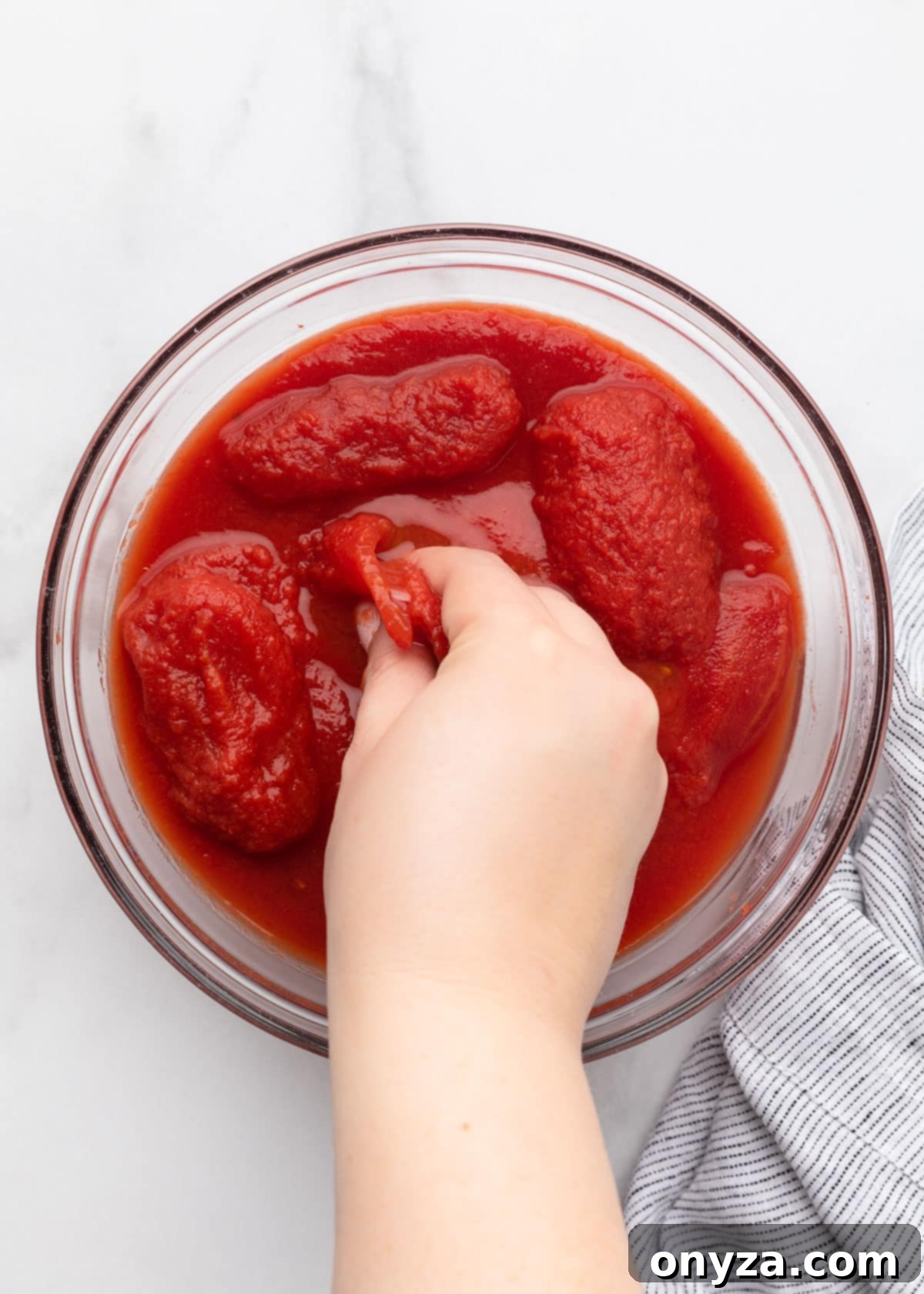
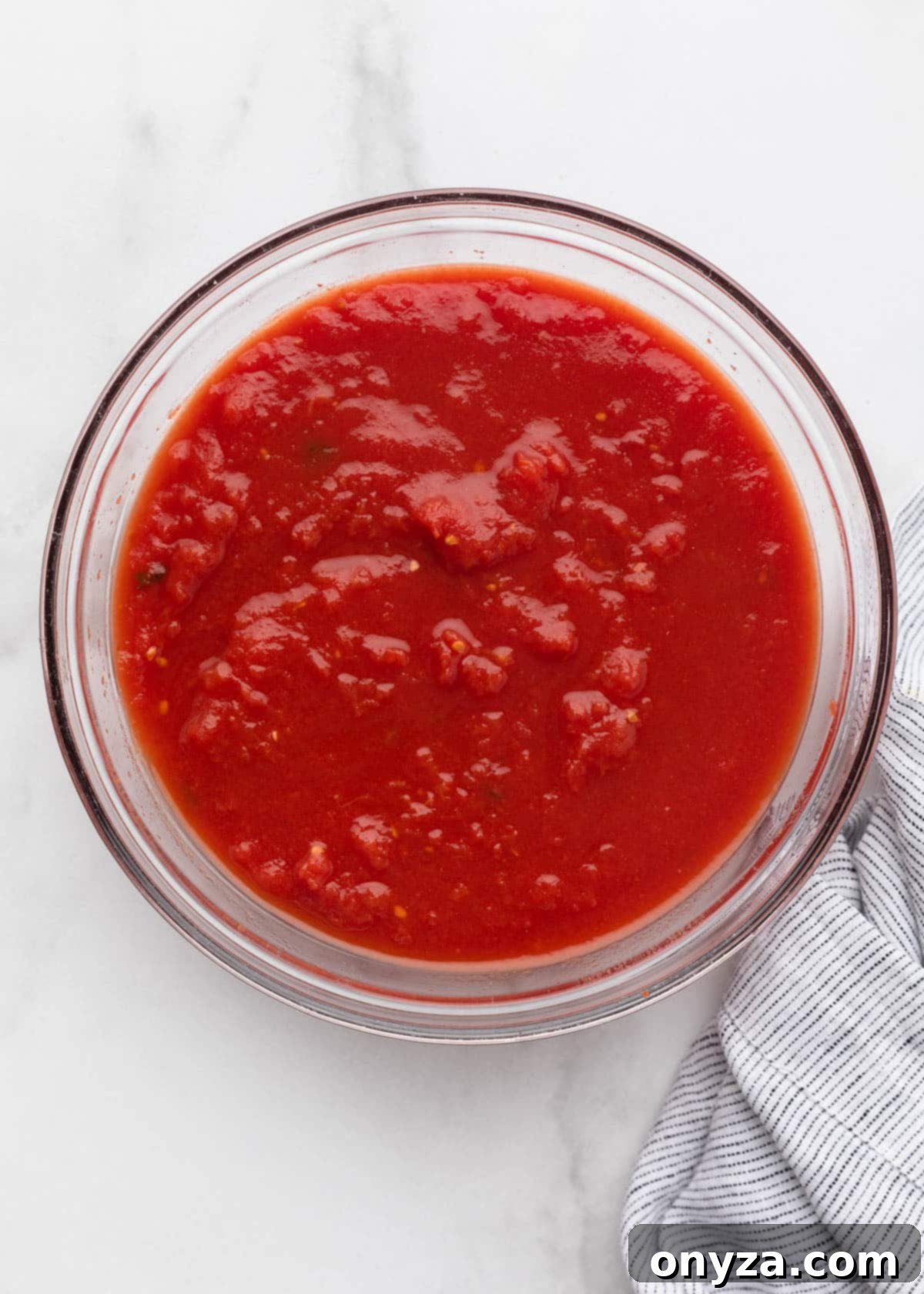
Step 2: Assembling the Soup – Layers of Flavor
To embark on your Minestrone creation, you’ll need a spacious, heavy-bottomed pot or a trusty Dutch oven. A 6.75-quart Le Creuset Round Wide Dutch Oven is an ideal choice, perfect for simmering hearty soups like Minestrone.
Rendering the Pancetta: Building the Flavor Base
We begin by establishing the soup’s robust flavor foundation with pancetta. Add a splash of quality olive oil and your diced pancetta to a cold pot. Then, place it over medium heat. This gradual warming from a cold start is crucial; it helps the pancetta slowly render its fat evenly, infusing the oil with its rich, savory essence without immediately crisping the meat. Cook for 3–4 minutes, stirring occasionally. The objective here is to gently render the fat, allowing the pancetta to soften and contribute its distinctive taste to the cooking oil.
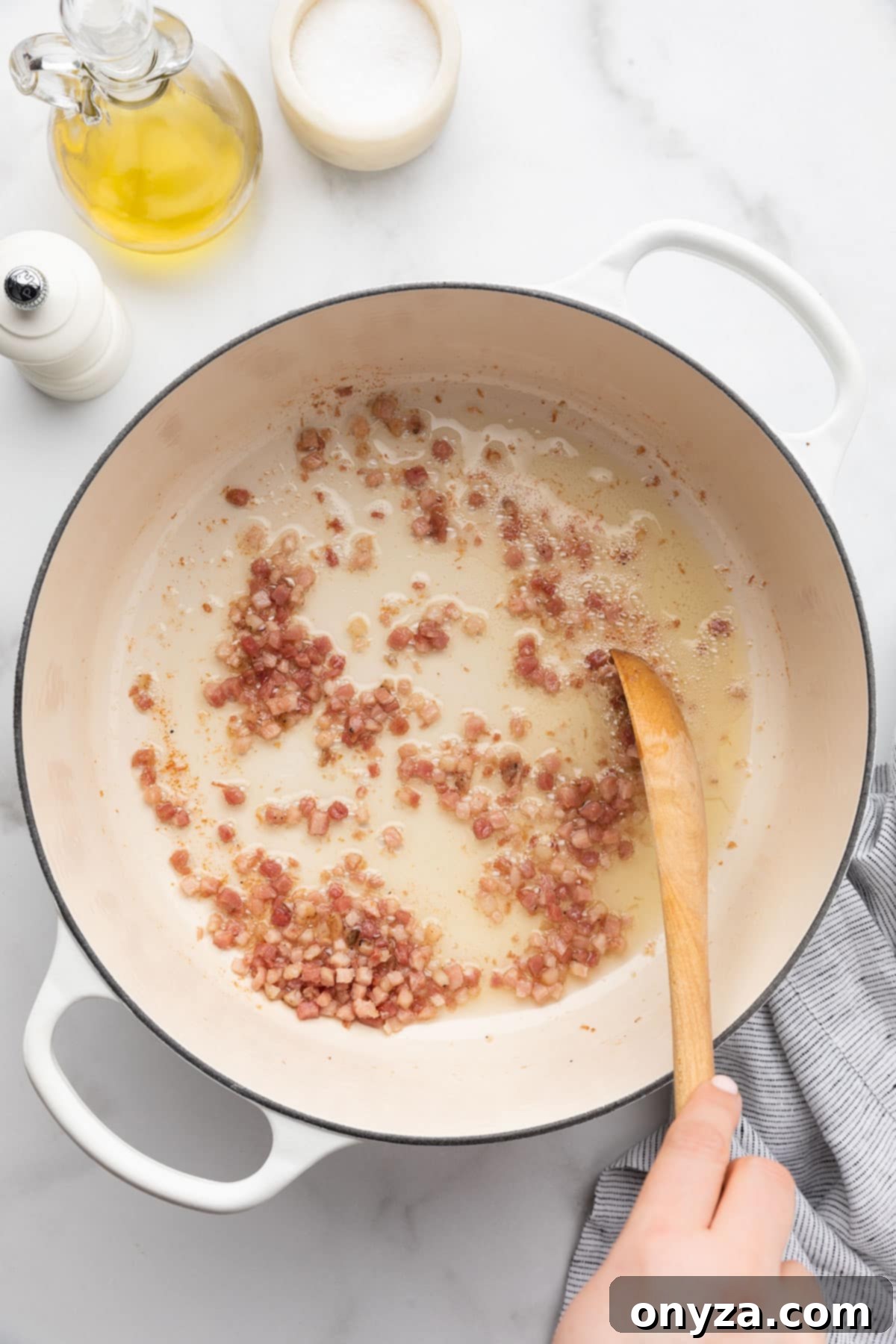
Sautéing the Aromatics: Unlocking Deep Tastes
Once the pancetta has generously rendered its fat, introduce your prepared onions, carrots, and celery (your aromatic mirepoix) to the pot. Season them lightly with kosher salt and freshly ground black pepper. Continue cooking this vibrant mixture over medium heat for approximately 10-12 minutes. Stir every couple of minutes to ensure even cooking, aiming for vegetables that are tender and fragrant but not yet caramelized. This gentle sautéing process softens their textures and deepens their natural sweetness, setting the stage for the soup’s overall flavor profile.
Chef’s Tip: The amount of fat rendered from pancetta can vary with each batch. Keep a watchful eye on your vegetables as they cook. If you notice the mixture beginning to stick to the bottom of the pot, or if it appears there isn’t quite enough fat to properly soften the vegetables, simply add a touch more olive oil to the pot as needed. This ensures consistent cooking and flavor development.

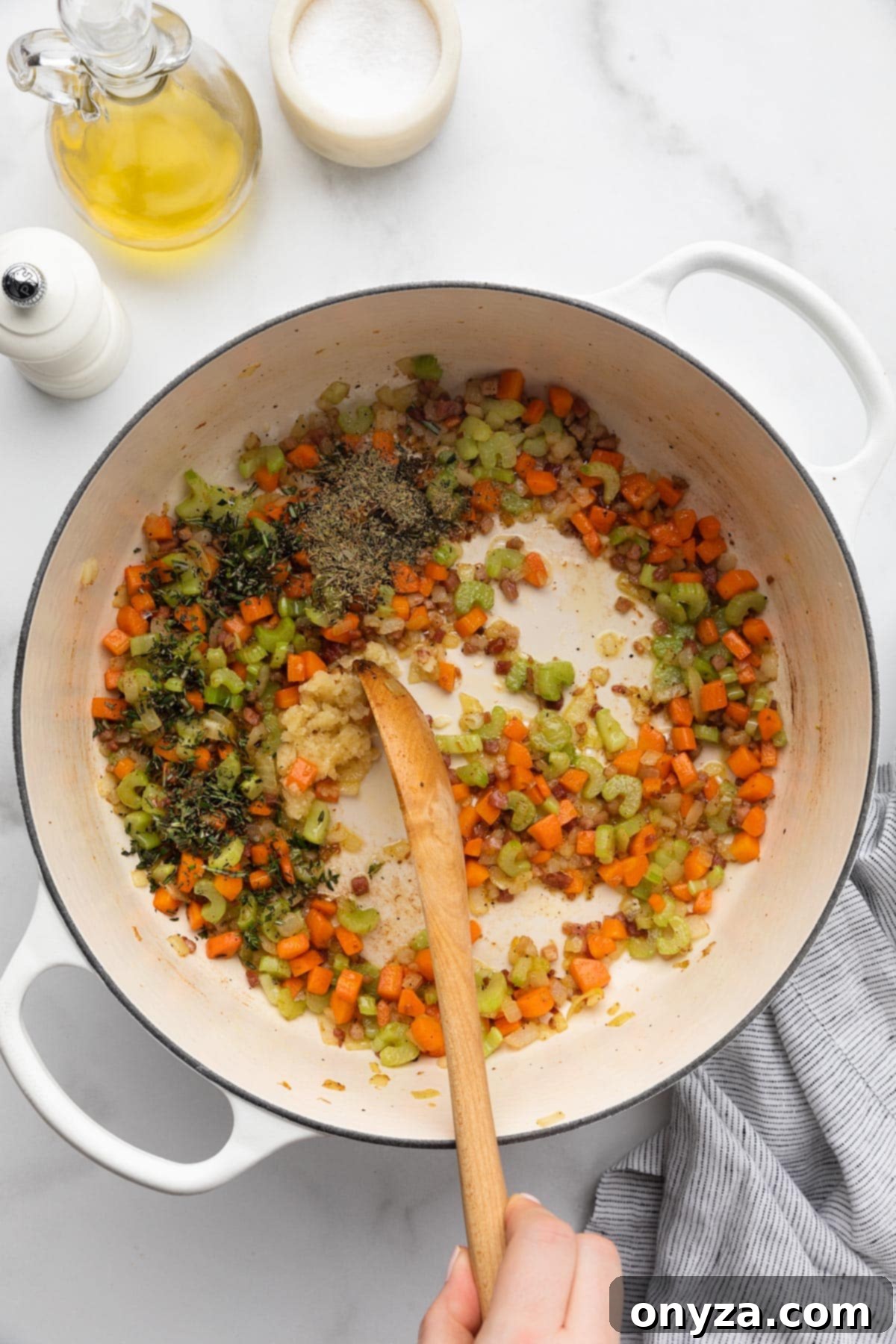
Once your vegetables have reached the desired tenderness, it’s time to introduce the aromatic powerhouses. Stir in the minced garlic, fresh rosemary, fresh thyme, and your favorite dried Italian herb blend (often labeled “Italian Seasoning” in grocery stores). Cook this fragrant mixture for just about a minute. This brief cooking period allows the garlic to mellow slightly and the herbs to bloom, releasing their intoxicating aromas and deeply infusing the vegetables with their essence.
Adding the Heart of the Soup: Tomatoes, Vegetables, and Broth
With the aromatics perfectly softened and fragrant, it’s time to incorporate the ingredients that give Minestrone its characteristic heartiness and texture. Add the hand-crushed plum tomatoes to the pot, stirring well to ensure they are thoroughly combined with the mirepoix. Next, introduce the green beans, zucchini, cannellini beans, and kidney beans, giving everything a good stir to integrate these fresh additions.
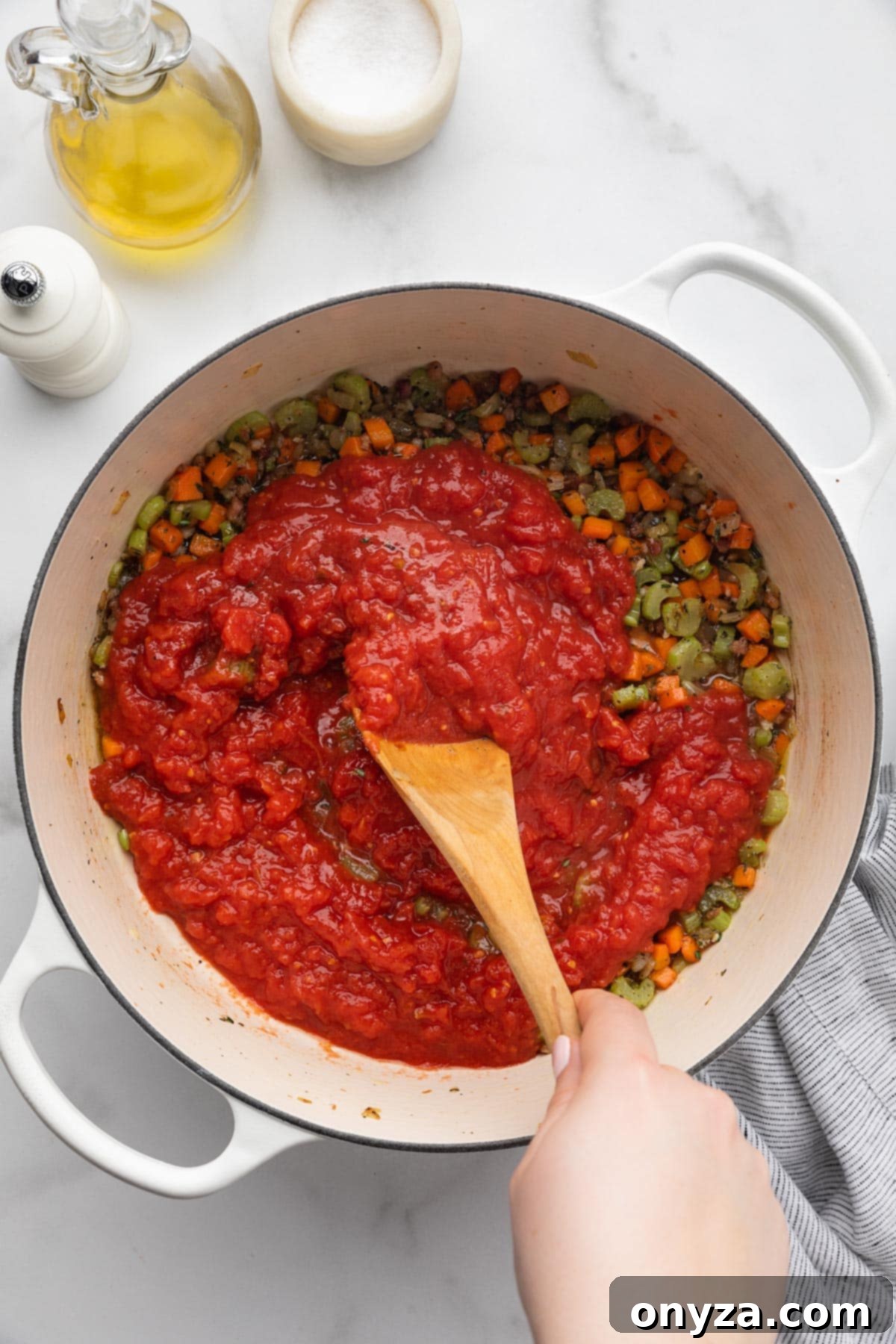
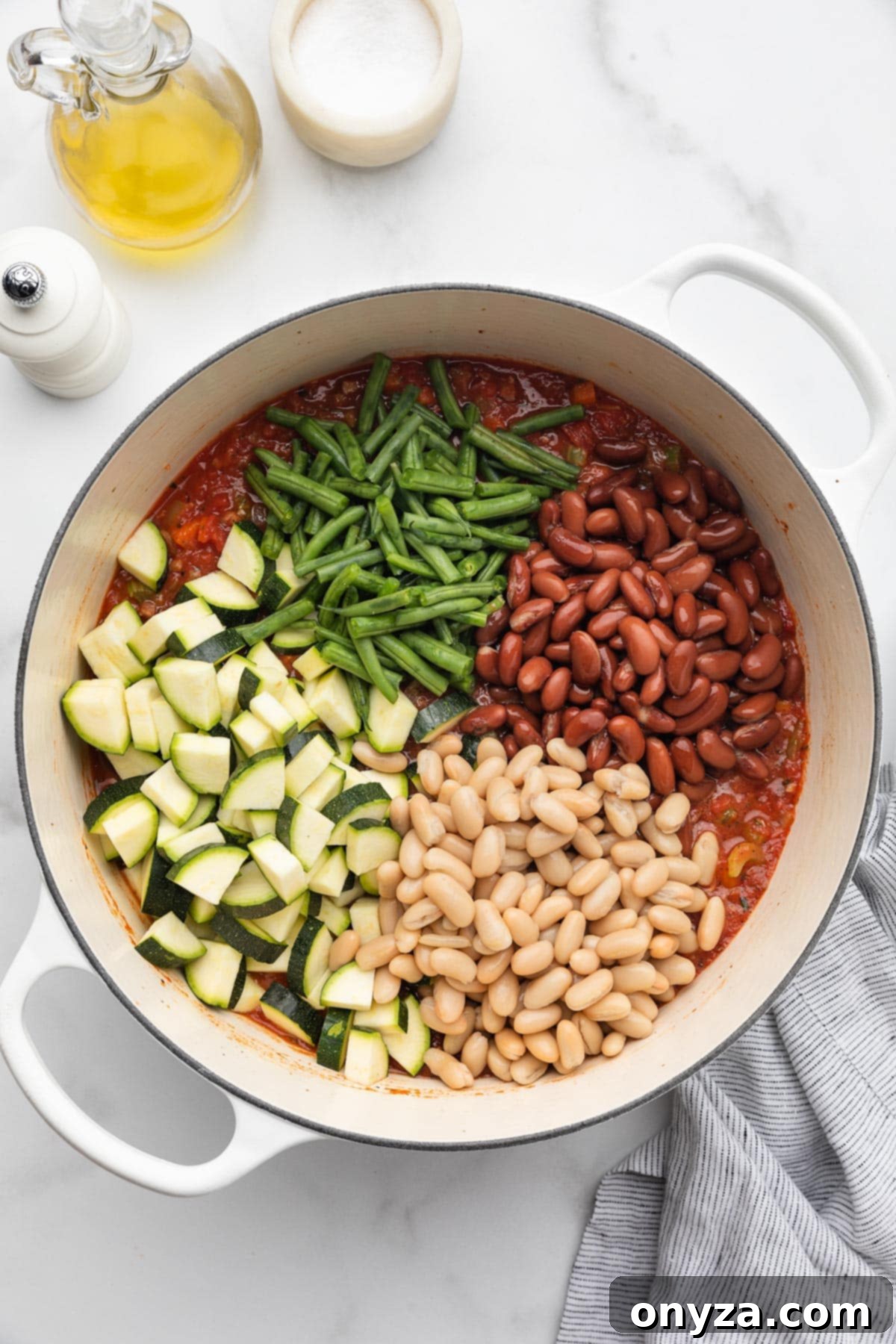
Now, pour in the chicken or vegetable broth (or stock) and stir everything until it’s thoroughly combined. Chicken stock typically offers a richer flavor, but if you’re preparing a vegetarian version, opt for a high-quality vegetable stock. Before bringing the soup to a simmer, add a large bay leaf and, for an extra layer of savory depth, a Parmigiano Reggiano rind. This is a brilliant culinary hack to infuse the broth with an unparalleled umami flavor. I always keep Parmigiano rinds in my freezer for just such occasions. If you don’t have one handy, check the gourmet cheese counter at your local grocery store; many sell containers of rinds specifically for cooking.
Broth Selection Tip: When using store-bought stock, I highly recommend choosing one with a moderate sodium level (around 440 mg per cup is ideal). Some brands contain 800+ mg of sodium per cup, which, when combined with the saltiness from pancetta, canned tomatoes, and beans, can quickly make your soup overwhelmingly salty. Always taste and adjust seasoning at the end.
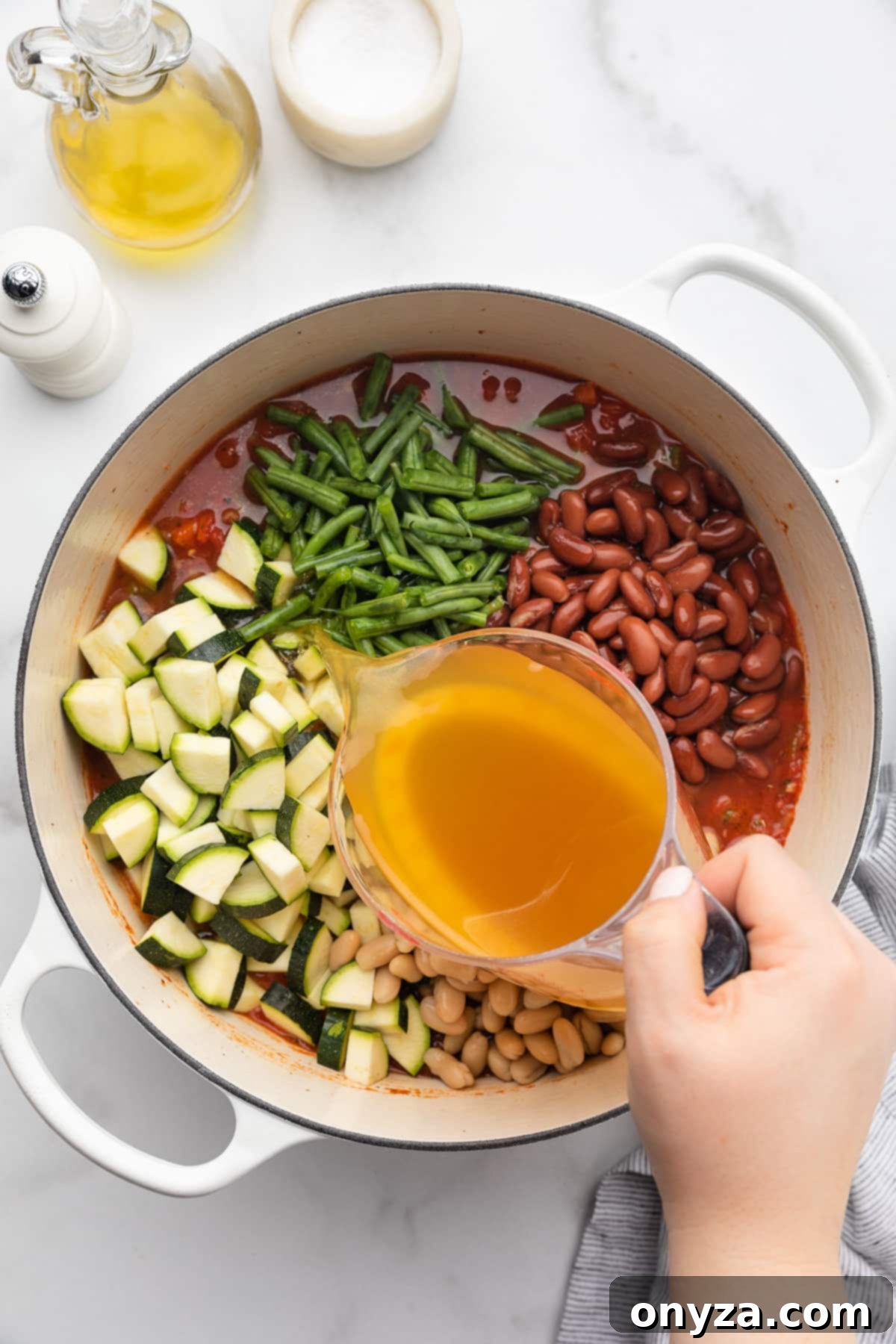

Step 3: Simmering to Perfection – Vegetables and Pasta
Your Minestrone Soup will simmer in two distinct stages: first, covered to tenderize the vegetables, and then uncovered when the pasta is added.
Simmer the Vegetables: Bring the soup to a rolling boil. Once boiling, cover the pot and immediately reduce the heat to maintain a gentle simmer. Allow it to cook for 20–25 minutes, giving it a stir every so often. During this phase, you’ll notice the soup subtly thickening as the beans release their starches into the savory broth, contributing to its hearty texture.
Add the Pasta: Uncover the pot and stir in 2/3 cup of dried short-cut pasta. I particularly love using tiny shells, but ditalini, mini farfalle (farfallini), or stelline are all excellent choices that integrate beautifully into the soup.
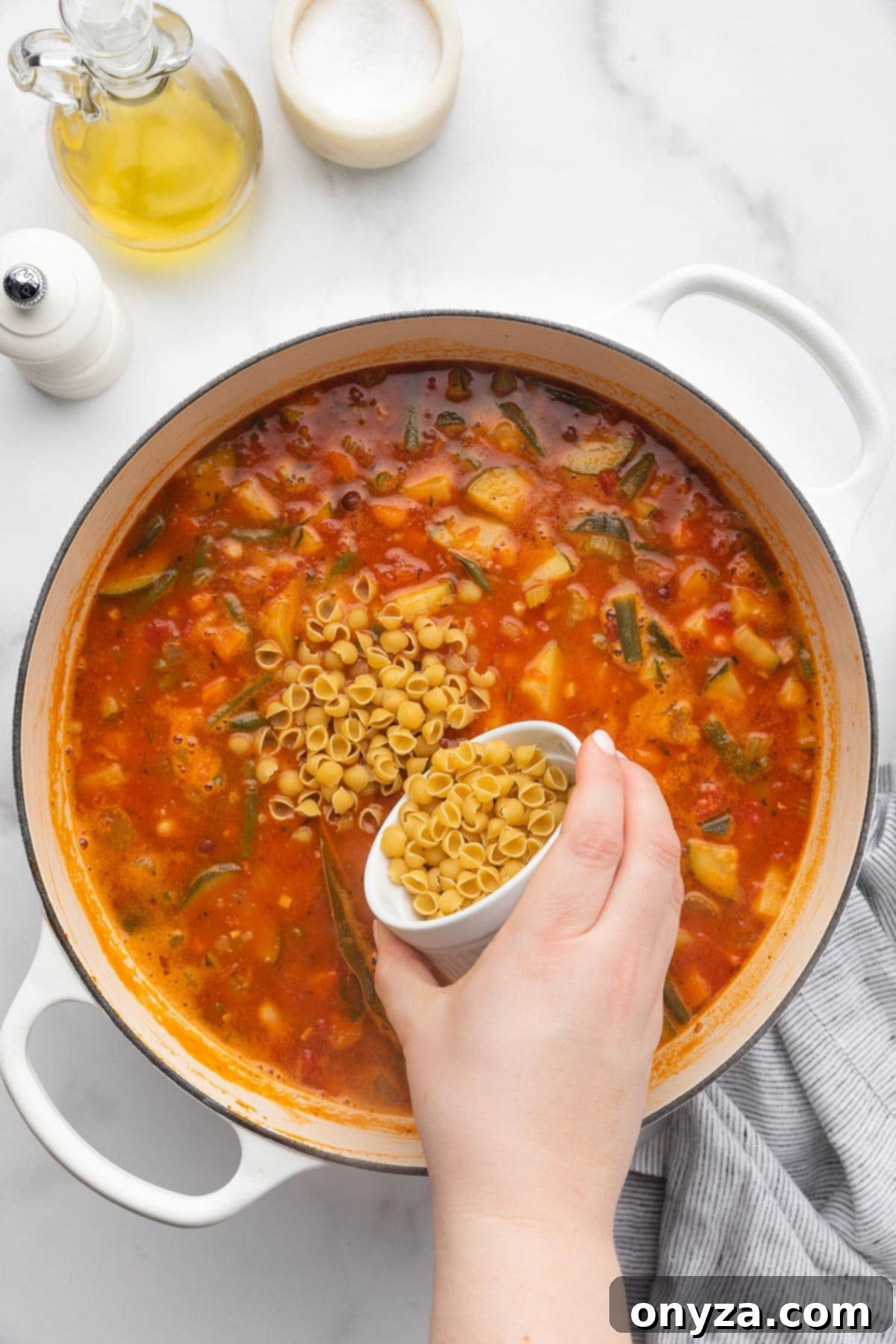
Pasta Portioning Tip: At first glance, 2/3 cup of pasta might seem like a modest amount for a large pot of soup, but trust the process! Minestrone is a symphony of ingredients, and you want to ensure the pasta complements, rather than overwhelms, the vegetables and beans. Remember, pasta continues to absorb broth even after cooking, so adding too much upfront will result in an overly thick, pasta-heavy soup as it cools and sits.
Allow the soup to simmer for approximately 10 minutes, or until the pasta is cooked to your desired tenderness. Cooking times can vary based on the pasta shape and brand, so be sure to taste-test a piece as you go to achieve that perfect al dente bite. As the pasta cooks, it will release additional starches, further thickening the broth naturally. Stir the soup occasionally during this stage to prevent the pasta from sticking to the bottom of the pot and to ensure everything is evenly distributed.
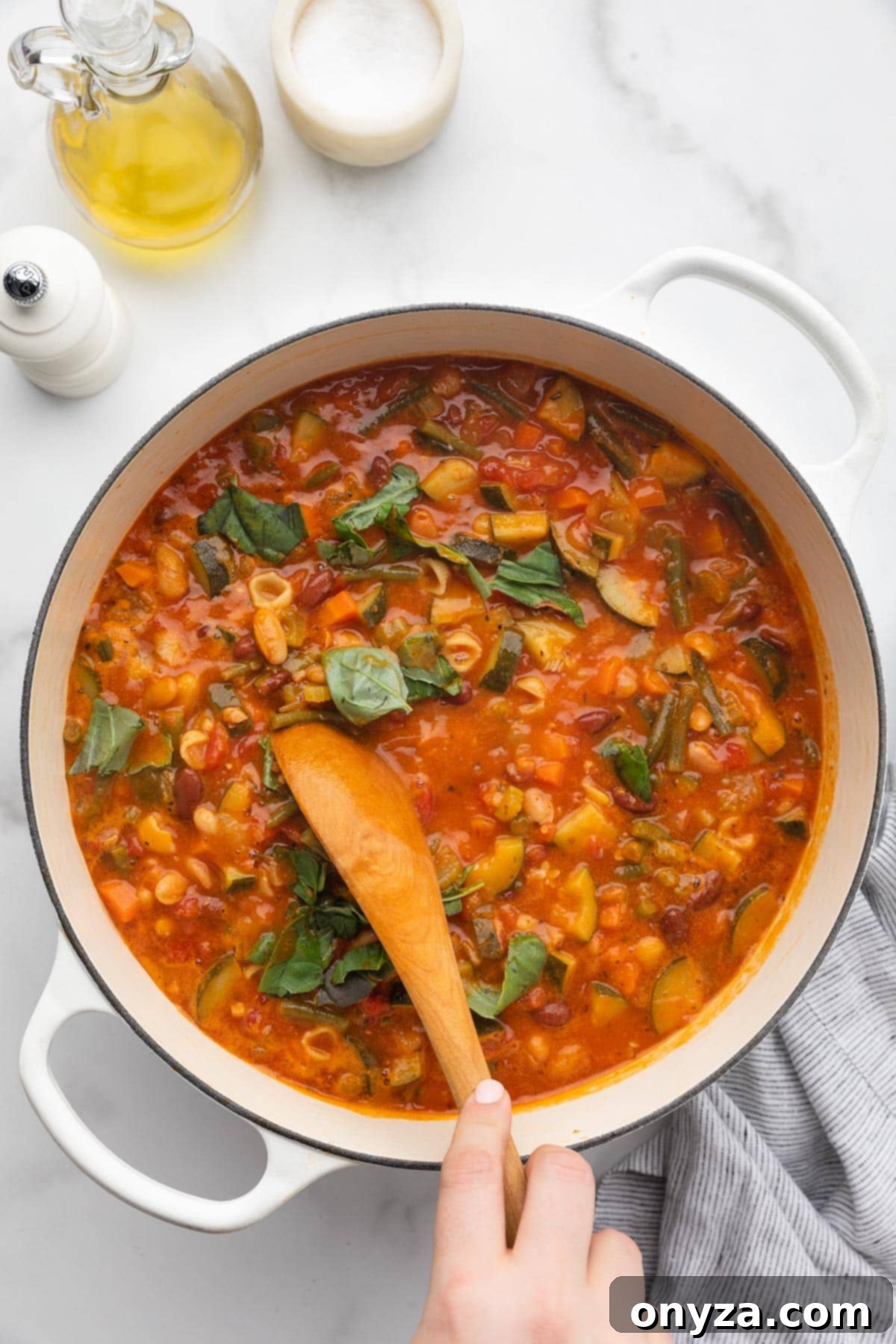
Step 4: Finishing Touches and Seasoning Perfection
Once the pasta is perfectly cooked, your Minestrone Soup is almost ready for the table! Carefully remove and discard the Parmigiano Reggiano rind (it will be wonderfully soft and melty from its flavor contribution) and the bay leaf.
Now, assess the texture of your broth. A classic Minestrone should be hearty, but if the pasta and beans have thickened it more than you prefer, simply add additional broth or stock, 1/2 cup at a time, until you achieve your desired consistency. For context, I typically add about 1 cup of extra broth to achieve the perfect richness, but this can vary. On one occasion, I only needed 1/2 cup, demonstrating how the absorption rate of pasta and beans can differ with each batch.
Adjusting the Seasoning: The Final Flourish
Once the broth’s consistency is to your liking, it’s critical to taste the soup and adjust the seasoning. Add salt and pepper as needed. If you used a low-sodium broth, you’ll likely need to be more generous with the salt to truly bring out the complex flavors of the vegetables and herbs. This final seasoning adjustment is key to a perfectly balanced soup.
Just before serving, take 6 to 8 fresh basil leaves and tear them by hand. Stir these fragrant pieces into the hot soup. The residual heat will gently wilt the basil, releasing its beautiful aroma and adding a bright, fresh, herbaceous finish that elevates the entire dish.
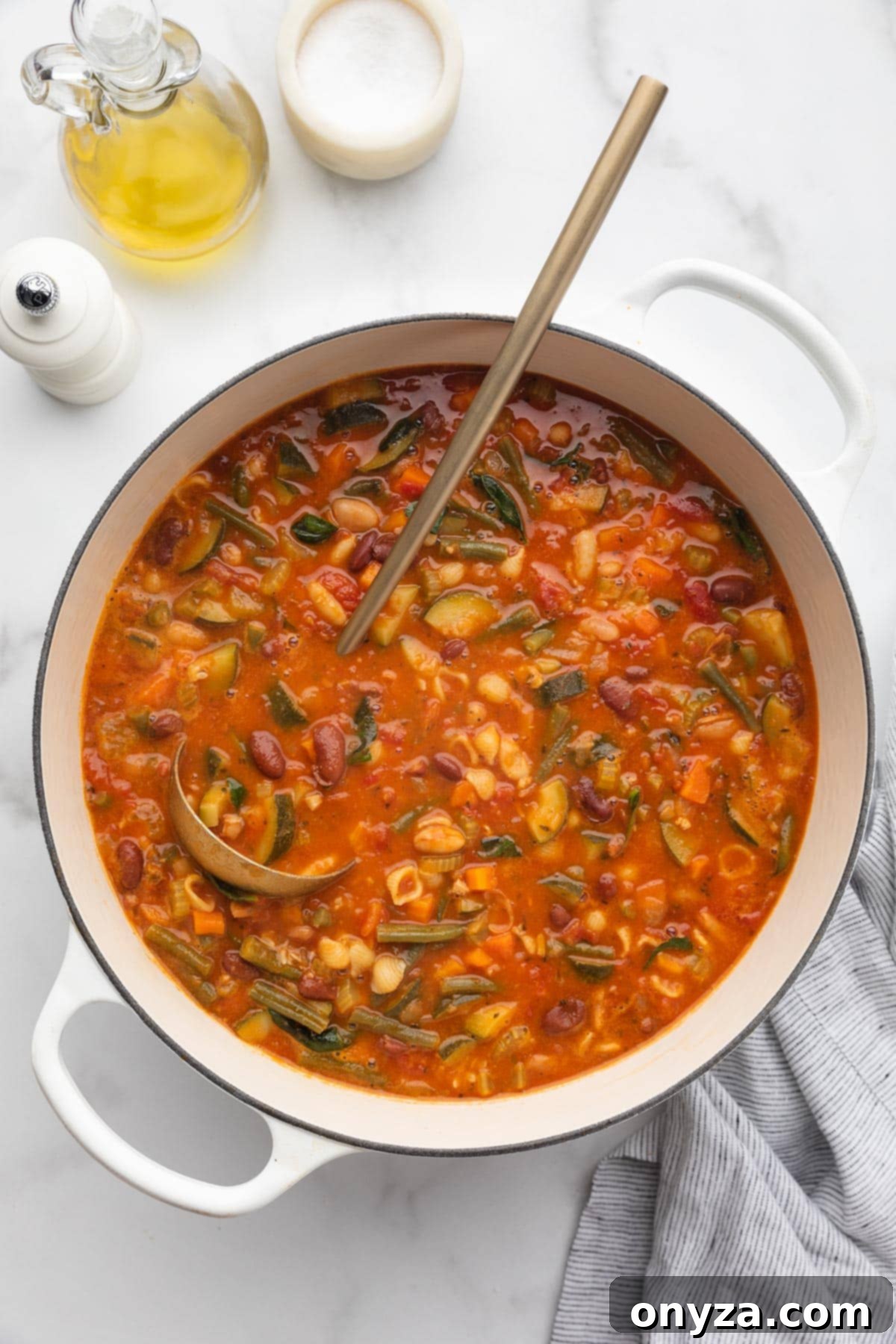
Endless Possibilities: Minestrone Variations and Substitutions
The beauty of Minestrone lies in its incredible flexibility. It’s a canvas for your culinary creativity, easily customized with whatever fresh vegetables and beans you have on hand. Don’t hesitate to experiment and make it your own! Here are some fantastic swaps and additions to inspire you:
- Leafy Greens: Roughly chop about 2 cups of your favorite greens. Delicate baby spinach will only need 1-2 minutes to wilt; stir it in with the basil just before serving. Heartier greens like kale, Swiss chard, or escarole will require a bit more time, closer to 5 to 7 minutes, to soften beautifully.
- Cabbage (Green or Savoy): For a different textural and flavor dimension, thinly slice or chop about 2 cups of green or Savoy cabbage. Add it to the pot along with the other vegetables and broth during the first stage of simmering.
- Peas or Corn: These sweet additions bring a burst of freshness. Add them fresh or frozen to the soup when you introduce the pasta, allowing them to cook through briefly.
- Summer Squash: Feel free to swap out zucchini for yellow summer squash, or use a delightful half-and-half mix of both. The cooking time will remain the same.
- Potatoes: For an even heartier and more substantial soup, incorporate peeled and diced Yukon Gold, russet, or sweet potatoes (aim for 1/2-inch cubes). Add them to the pot during the initial simmering stage with the other vegetables.
- Butternut Squash: Dice peeled butternut squash into 1/2-inch cubes and add it during the first stage of simmering. Its sweet, earthy notes complement the tomato base beautifully.
- Other Bean Varieties: Expand your bean horizons! Cooked or canned dark red kidney beans, navy beans, chickpeas, or borlotti (cranberry beans) are all excellent substitutes or additions.
When incorporating these swaps, always consider the starch content of your additions. Ingredients like potatoes, butternut squash, and certain beans will naturally thicken the soup and make it more filling. For instance, if you’re adding both potatoes and butternut squash, you might want to reduce the amount of beans from two cans to one to prevent the soup from becoming overly dense or heavy. Always keep extra broth or stock on hand to adjust the consistency as needed, ensuring your Minestrone is just right.
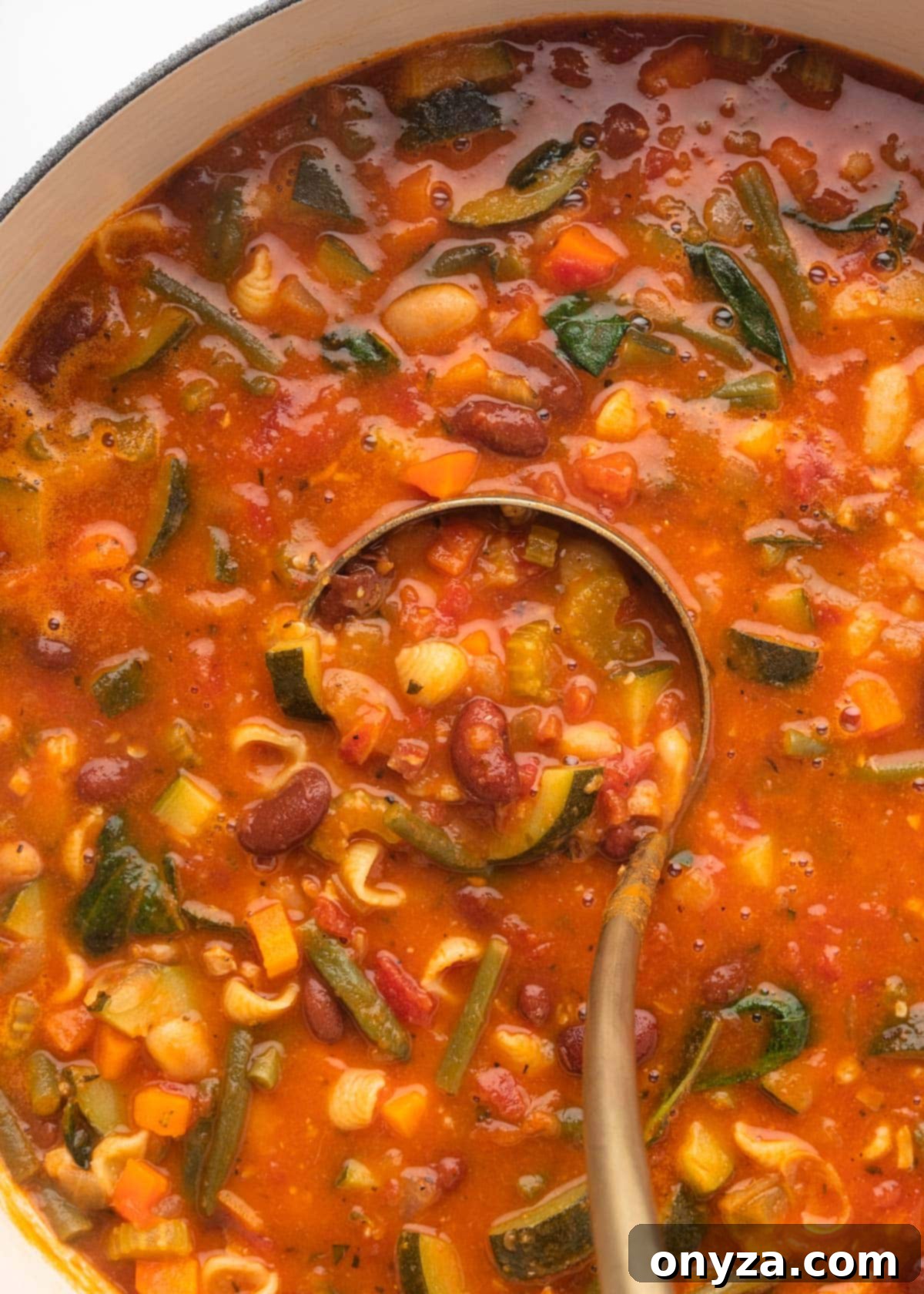
Serving Your Minestrone: Elevating the Experience
Serving Minestrone is an art in itself, offering opportunities to enhance its already rich flavors and textures. Ladle the steaming hot soup into individual bowls, creating an inviting presentation. Finish each serving with a generous drizzle of high-quality extra virgin olive oil, which adds a silky mouthfeel and peppery note, a liberal sprinkle of freshly grated Parmigiano Reggiano, and a few fresh grinds of black pepper.
For an additional boost of bright, herbaceous flavor, swirl in a spoonful of basil pesto—it’s a game-changer! If you appreciate a little heat, a pinch of crushed red pepper flakes stirred into your bowl will add a delightful kick. Serve your Minestrone alongside warm, crusty Italian bread, perfect for dipping and soaking up every last drop of the savory broth. Alternatively, for an added layer of crunch and garlic goodness, top your soup with a handful of homemade buttery garlic croutons.
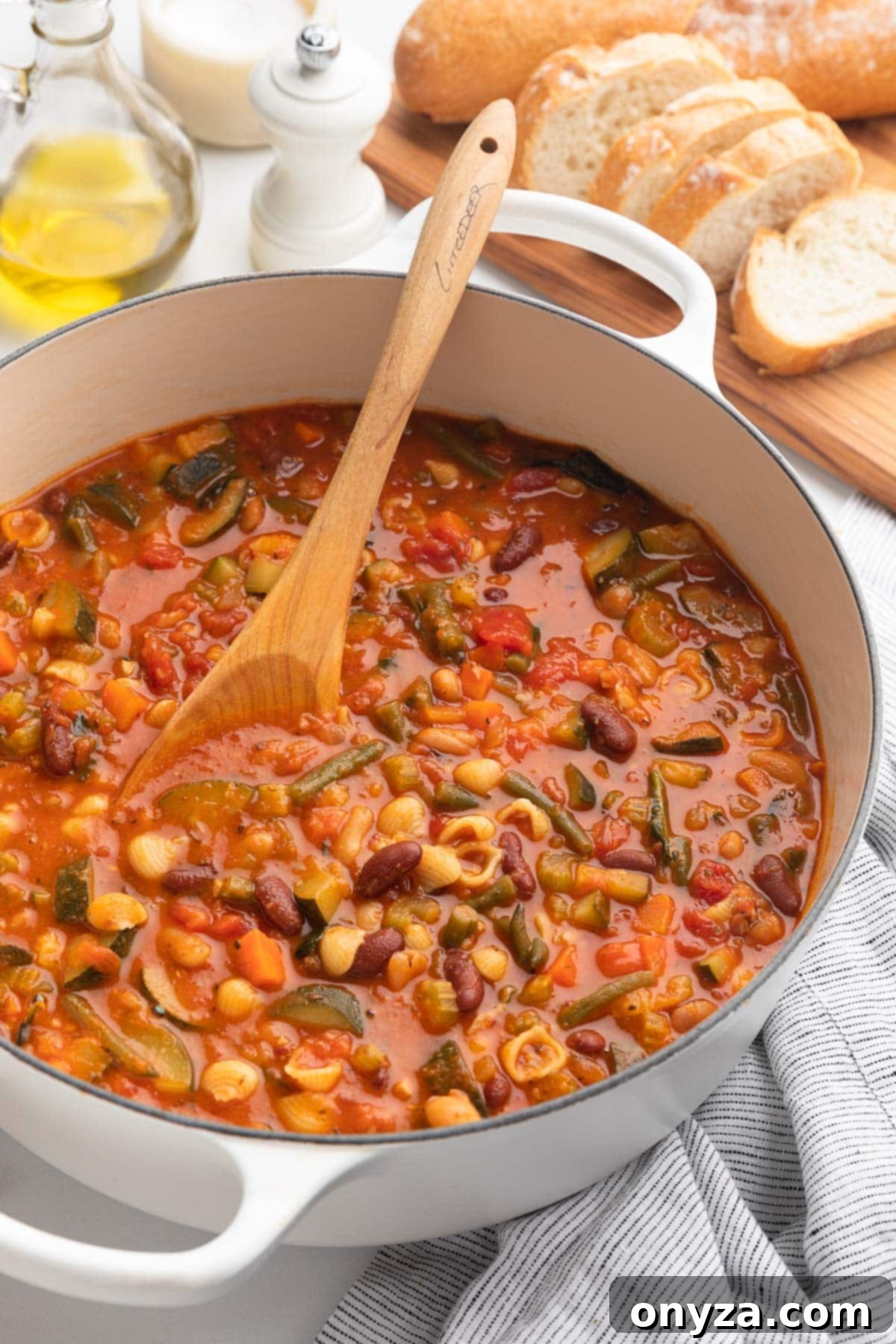
Storing & Reheating Minestrone Soup
Minestrone is a fantastic make-ahead meal, often tasting even better the next day as the flavors meld and deepen. It keeps beautifully in the refrigerator for up to 4 days. Store any leftovers in an airtight container to maintain freshness and prevent other food odors from permeating the soup.
You’ll find that the soup thickens significantly as it chills, a natural occurrence due to the starches released from the pasta and beans. When reheating, it’s essential to add extra broth or stock to bring it back to your desired consistency. Start with half a cup and add more gradually, stirring until it’s just right. Always taste and re-season with salt and pepper after reheating, as flavors can sometimes mellow in the fridge.
Make-Ahead Tip for Perfect Pasta
If you’re preparing a large batch of Minestrone Soup specifically to serve at a later time, or if you anticipate having leftovers, I highly recommend cooking the pasta separately. This crucial step prevents the pasta from becoming overly soft, mushy, or absorbing too much broth, ensuring a perfect texture every time.
- Cook your chosen short-cut pasta in broth or stock instead of plain water for an extra layer of savory flavor.
- Once the pasta is cooked, drain it, cool it slightly, and toss it with a small drizzle of olive oil. This prevents the individual pieces from sticking together.
- Store the cooled, dressed pasta in an airtight container in the refrigerator, separate from the main soup.
- When you’re ready to serve the soup, simply stir in the pre-cooked pasta and reheat gently until warmed through.
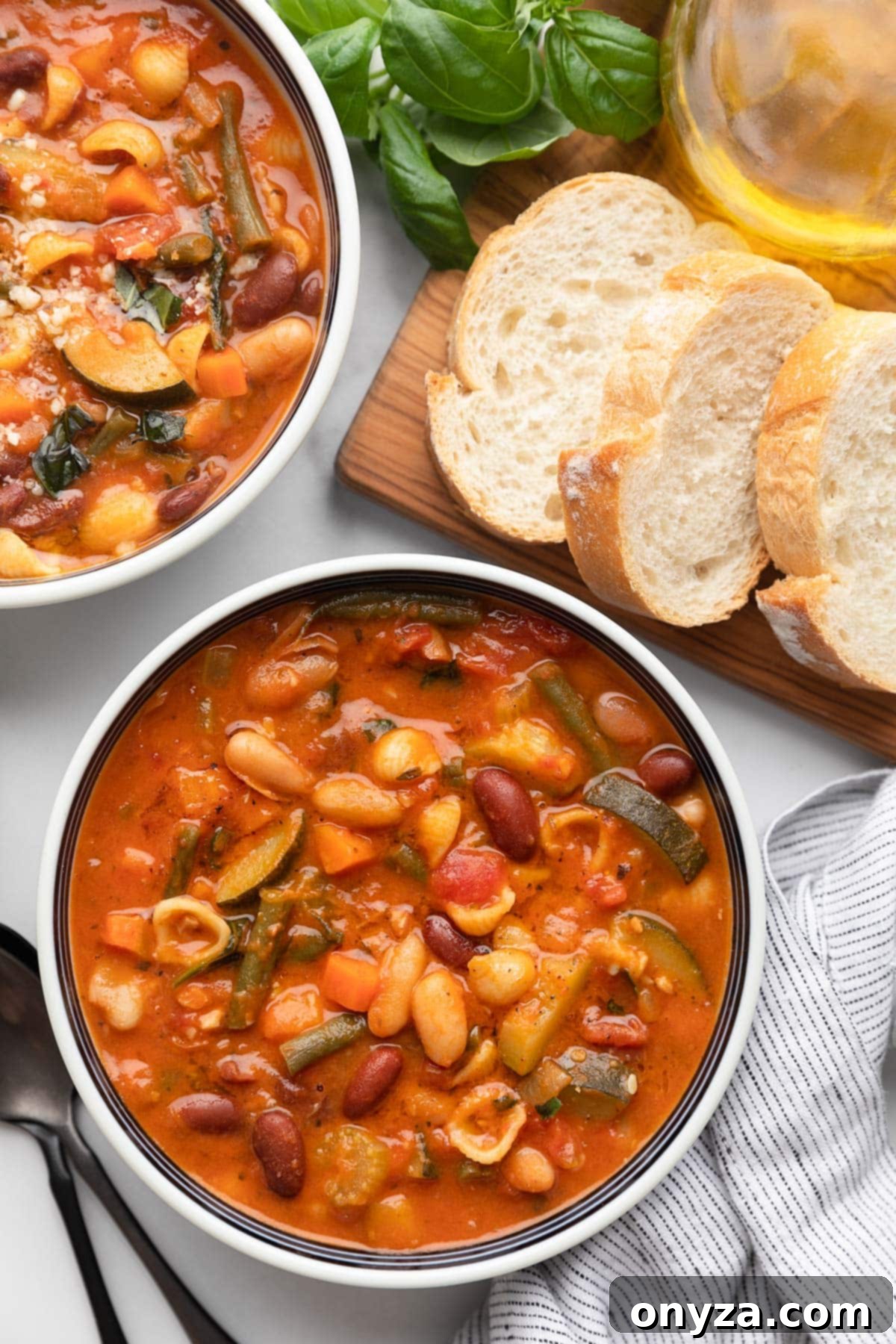
Explore More Comforting Soup Recipes
If you’ve enjoyed the comforting embrace of this Minestrone Soup, you’re sure to love these other heartwarming recipes from our collection:
- Hearty Split Pea Soup with Ham
- Classic Italian Wedding Soup
- Creamy Chicken Gnocchi Soup
- Rich & Creamy Sausage Tortellini Soup
- Velvety Broccoli Cheddar Soup
Craving more deliciousness? Dive into my full collection of Soup & Stew Recipes for endless culinary inspiration!
Classic Minestrone Soup Recipe
This hearty Minestrone Soup recipe is loaded with a colorful array of vegetables, wholesome beans, and tender pasta, all simmered in a rich, flavorful broth. It’s a comforting Italian classic that’s incredibly easy to customize with whatever fresh ingredients you have on hand. Perfect for a cozy weekend meal or a make-ahead dinner that the entire family will adore!
Prep Time: 30 minutes
Cook Time: 1 hour 5 minutes
Total Time: 1 hour 35 minutes
Yields: 8 to 10 servings
Author: Amanda Biddle
Ingredients
- 4 ounces pancetta, diced small (about 1/8- to 1/4-inch)
- 2 tablespoons olive oil, plus additional, if needed
- 1 cup yellow onion, peeled and chopped into 1/4-inch pieces
- 1 cup carrots, peeled and cut into 1/4-inch dice
- 1 cup celery, cut into 1/4-inch thick slices
- 2 teaspoons minced garlic cloves
- 1 teaspoon finely chopped fresh rosemary
- 1 teaspoon finely chopped fresh thyme leaves
- 1 teaspoon dried Italian seasoning (“Italian Herbs”)
- 28 ounce can whole plum tomatoes (preferably San Marzano), finely crushed by hand
- 15 ounce can cannellini beans, rinsed and drained
- 15 ounce can light red kidney beans, rinsed and drained
- 2 cups quartered zucchini wedges (see note below for cutting)
- 1 cup cut green beans (fresh, trimmed to 1-inch pieces, or frozen cut green beans)
- 6 to 8 cups reduced sodium chicken or vegetable broth/stock (see note below for sodium levels)
- 1 large bay leaf
- 1 Parmigiano Reggiano rind
- ⅔ cup dried miniature shell pasta, or other short-cut pasta of your choosing (ditalini, mini farfalle, stelline)
- Diamond Crystal kosher salt and freshly-ground black pepper, to taste
- Grated Parmigiano Reggiano, for serving
- Fresh basil leaves, torn, for serving
- Extra virgin olive oil, for serving (optional)
- Crushed red pepper flakes, for serving (optional)
Instructions
- In a large, heavy-bottomed pot (a 6.75-quart Dutch oven works perfectly), add the olive oil and diced pancetta *before* heating the pot. Place it over medium heat and cook for 3–4 minutes, stirring occasionally, until the pancetta renders its fat and softens, but does not brown or crisp.
- Add the chopped onions, celery, and carrots to the pot. Season with 1/2 teaspoon each of kosher salt and freshly ground black pepper. Cook over medium heat, stirring occasionally, for about 10–12 minutes, until the vegetables are tender but not caramelized. (If the mixture starts sticking, add a little extra olive oil.)
- Stir in the minced garlic, finely chopped rosemary, thyme, and dried Italian seasoning. Cook for about 1 minute, or until wonderfully fragrant.
- Add the hand-crushed plum tomatoes (with their juices/purée) to the pot, stirring to combine. Follow with the rinsed and drained cannellini beans, kidney beans, quartered zucchini, and cut green beans.
- Pour in 6 cups of broth or stock and stir until all ingredients are well combined. Add the bay leaf and the Parmigiano Reggiano rind.
- Bring the soup to a boil, then immediately cover the pot and reduce the heat to maintain a gentle simmer. Cook, covered, for 20–25 minutes, stirring a couple of times, until the vegetables are tender. The soup will begin to thicken slightly.
- Uncover the pot and give the soup a stir. Add the ⅔ cup of dried miniature shell pasta (or your chosen short-cut pasta). Continue to simmer uncovered for about 10 minutes, or until the pasta is tender to your liking. Stir occasionally to prevent the pasta from sticking to the bottom of the pot.
- Once the pasta is cooked, carefully remove and discard the Parmigiano Reggiano rind and the bay leaf. Check the soup’s consistency; if it’s too thick, stir in additional broth or stock, 1/2 cup at a time, until you reach your desired texture. The amount needed may vary.
- Taste the soup and adjust the seasoning with salt and freshly ground black pepper as needed. Just before serving, roughly tear the fresh basil leaves and stir them into the soup until they gently wilt.
- Ladle the hot soup into bowls. Finish each serving with a drizzle of extra virgin olive oil, a generous sprinkle of freshly grated Parmigiano Reggiano, and a few grinds of black pepper. For a spicy kick, add a few crushed red pepper flakes. Serve immediately with warm, crusty Italian bread for dipping.
Recipe Notes
- The soup will naturally continue to thicken as it sits and cools due to the starches from the beans and pasta. When reheating, simply add additional stock or broth as needed to thin it back out to your preferred consistency, and re-season to taste.
- Vegetarian Option (Pancetta): To make this Minestrone vegetarian, simply omit the pancetta entirely. When sautéing the onions, carrots, and celery, use 1–2 extra tablespoons of olive oil to provide the necessary fat and richness.
- Zucchini Preparation: Cut the unpeeled zucchini into 1/4-inch thick rounds, then quarter each round. If your zucchini is larger than 1-1/2 inches in diameter, it’s best to chop it into 1/2-inch pieces instead for even cooking.
- Green Bean Options: You can use either fresh (trimmed and cut into 1/2-inch lengths) or frozen cut green beans. If using frozen, there’s no need to defrost them; just add them directly to the soup.
- Broth/Stock Sodium: When opting for store-bought broth, I recommend a moderate-sodium chicken or vegetable stock (around 440 mg of sodium per cup). Avoid full-sodium stocks (800+ mg per cup), as the combination with pancetta, canned tomatoes, and beans can result in an overly salty soup once simmered and reduced.
- Broth Amount: Start with 6 cups of broth or stock, but keep an additional 2 cups on hand to adjust the soup’s thickness to your liking throughout the cooking and reheating process.
